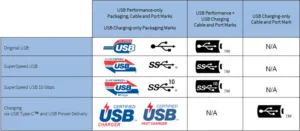We met with the USB Implementors Forum in its suite and we started by hearing of the latest developments in USB 3.2 which was announced in the summer of 2017. The latest version has been developed to support multi-lane operation that could take data rates up to 2TB/sec for data storage or up to a level of performance to support USB Display at 84/60 or 4K/120 with DSC or 4k/60 without. One of the design considerations was to maintain compatibility, so the new version can double the performance with existing certified Type-C cables. (USB 3.2 Announced)
The Forum is in discussion about protocols for future developments of USB Display and there is a concept of ‘Transport Agnostic Display’ which is being developed to separate display data from the hardware layer (to be more like a classic networking layer model).
One of the features that the new version supports is the support of dual 5 Gbps lanes, as well as dual 10 Gbps. Why would you use dual 5Gbps instead of a single 10Gbps lane? The reason is cable length and there are industrial and automotive applications which would prefer more robustness over longer cables,
The Forum expects products that can support V3.2 to be available in the market by 2019.
The group is working on a review to its branding to help consumers to better identify the version that is supported, and to ensure the correct cables. Cables will basically be marked with a 5, 10 or 20 to indicate the bandwidth that is supported. The final announcement will be later in 2018.
Power Delivery Moves On
USB has had some success with the Power Delivery specification, but there are still improvements that can be made. At the moment, a system and PSU can negotiate a choice of fixed voltages at 5,9, 15 or 20V. Now the USB-IF is developing a Programmable PSU standard to allow completely flexible negotiation between the device and power supply. As well as the voltage, devices will be able to specify an algorithm for the supply of power, allowing Fast Charging that is matched to the requirements of the device, whichever chipset is used in the device.
This should mean wider use of universal PSUs and the USB-IF expect some certified fast chargers this quarter.
One of the challenges of Power Delivery is that badly designed (and uncertified) PSUs could cause damage to devices. Therefore, the Forum has set up a certification scheme. On first connection, a device can get a key from the charger that can be authenticated. This can even be traced back to the USB-IF if the device is online, although this is not required. Once a device has been authorised, it will not need the process repeating. This means that devices can decide how open they want to be. depending on the certification. If the device can’t be sure of the charger, it can adopt a very conservative mode to protect itself.
USB is also working on developing chip to chip USB for applications including automotive.
The group is seeing more and more interest in docking mobile devices and initiatives such as Samsung’s Dex are becoming more widely supported. As we also heard from VESA, the Dex, like the Nintendo Switch, has an external HDMI connector, but uses the DisplayPort USB Type-C Alt mode.

